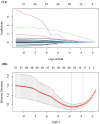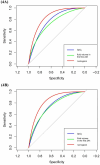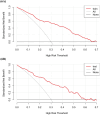A nomogram for individualized prediction of acute respiratory distress syndrome in patients with severe traumatic brain injury: a retrospective cohort study
- PMID: 40885957
- PMCID: PMC12398984
- DOI: 10.1186/s12890-025-03879-4
A nomogram for individualized prediction of acute respiratory distress syndrome in patients with severe traumatic brain injury: a retrospective cohort study
Abstract
Background: The prognosis of patients with a concomitance of severe traumatic brain injury (sTBI) and acute respiratory distress syndrome (ARDS) is poor, and early identification of such patients can provide diagnostic and therapeutic assistance for clinical treatment. However, few studies have been conducted to identify the risk of ARDS in patients with sTBI. This study aimed to construct a risk prediction model for ARDS in patients with sTBI and evaluate its efficacy.
Methods: From 2016 to 2023, 502 patients diagnosed with sTBI were selected from the Affiliated Hospital of Yangzhou University. All participants were randomly allocated to either the training or validation group. Feature selection for constructing the prediction model and developing a nomogram was carried out using the least absolute shrinkage and selection operator (LASSO) and multivariable logistic regression analysis. The effectiveness and clinical relevance of the model were evaluated using receiver operating characteristic (ROC) curves, the area under the ROC curve (AUC), calibration curves, and the decision curve analysis (DCA).
Results: The study found that 32.9% of patients with sTBI developed ARDS. The model was established based on oxygen saturation measured by pulse oximetry (SpO2), pneumonia, and fluid volume in the first 24 h. The model showed good discriminative ability with AUC values of 0.841 for the training and 0.821 for the validation groups. Calibration curves demonstrated that the predicted results align well with the actual results. The DCA suggested that the nomogram could lead to clinically beneficial outcomes at a significant threshold.
Conclusions: The diagnostic nomogram for ARDS in sTBI patients demonstrated satisfactory predictive value, assisting clinicians in identifying high-risk patients for ARDS.
Trail registration: ChiCTR2400085916.
Keywords: Acute respiratory distress syndrome; Nomogram; Prediction model; Severe traumatic brain injury.
Conflict of interest statement
Declarations. Ethics approval and consent to participate: This retrospective analysis was reviewed and authorized by the Ethics Committee of School of Nursing, Yangzhou University (YZUHL20230023). This study was registered on Chinese Clinical Trial Registry (ChiCTR2400085916). Informed consent was waived due to the anonymity of the data. Consent for publication: Not applicable. Competing interests: The authors declare no competing interests.
Figures






Similar articles
-
Development and validation of a dynamic nomogram for predicting enteral nutrition feeding intolerance in patients with severe traumatic brain injury: An external validation study.Medicine (Baltimore). 2025 Jun 27;104(26):e42993. doi: 10.1097/MD.0000000000042993. Medicine (Baltimore). 2025. PMID: 40587708 Free PMC article.
-
A nomogram for predicting risk factors for lower limb deep venous thrombosis in elderly postoperative patients with severe traumatic brain injury in the intensive care unit.Phlebology. 2025 Jul;40(6):446-455. doi: 10.1177/02683555251332988. Epub 2025 Apr 10. Phlebology. 2025. PMID: 40205921
-
[Development, comparison and validation of clinical predictive models for brain injury after in-hospital post-cardiac arrest in critically ill patients].Zhonghua Wei Zhong Bing Ji Jiu Yi Xue. 2025 Jun;37(6):560-567. doi: 10.3760/cma.j.cn121430-20240409-00322. Zhonghua Wei Zhong Bing Ji Jiu Yi Xue. 2025. PMID: 40820532 Chinese.
-
Partial liquid ventilation for the prevention of mortality and morbidity in paediatric acute lung injury and acute respiratory distress syndrome.Cochrane Database Syst Rev. 2013 Feb 28;2013(2):CD003845. doi: 10.1002/14651858.CD003845.pub3. Cochrane Database Syst Rev. 2013. PMID: 23450545 Free PMC article.
-
Lung protective ventilation strategy for the acute respiratory distress syndrome.Cochrane Database Syst Rev. 2013 Feb 28;2013(2):CD003844. doi: 10.1002/14651858.CD003844.pub4. Cochrane Database Syst Rev. 2013. PMID: 23450544 Free PMC article.
References
-
- Maas AIR, Fitzgerald M, Gao G, Gupta D, Hutchinson P, Manley GT, Menon DK. Traumatic brain injury over the past 20 years: research and clinical progress. Lancet Neurol. 2022;21(9):768–70. - PubMed
-
- Quaglio G, Gallucci M, Brand H, Dawood A, Cobello F. Traumatic brain injury: a priority for public health policy. Lancet Neurol. 2017;16(12):951–2. - PubMed
Grants and funding
LinkOut - more resources
Full Text Sources

